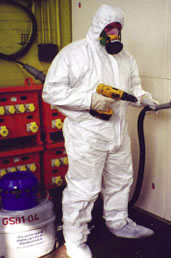Asbestos Air Testing UK: Ensuring Safety and Compliance
Last Updated on 3 October 2023
Understanding Asbestos Air Testing
In the United Kingdom as in most countries, there are significant concerns regarding asbestos exposure. As a result, strict measures have been put in place to ensure the safety of indoor environments. In the past, people widely used asbestos in construction materials due to its natural fire-resistant properties. However, it was later found that when asbestos fibres are released into the air and people breathe them in, it can lead to significant health problems such as lung diseases and cancer. In this article, we will explore the significance of asbestos air testing in the UK. We’ll discuss the process, regulations, and how it contributes to creating a safe and healthy living and working environment.
What is Asbestos Air Testing?
Air testing for asbestos is an important process that involves gathering and examining volumes of air pulled through a special filter to determine if there are any asbestos fibres present in the air. The process involves assessing the concentration of asbestos fibres in the air and determining the potential risk it poses to people occupying the area.
Testing for asbestos is especially important in buildings that were built prior to the year 2000, as this was a time when asbestos was commonly used in construction materials. When asbestos-containing materials (ACMs) like insulation, roofing, or flooring in older buildings deteriorate or are disturbed, asbestos fibres can be released into the air.
Why is Asbestos Air Testing Necessary?
Inhaling asbestos fibres can have serious health consequences. Exposure to asbestos can result in various health conditions, such as asbestosis, lung scarring, pleural plaques and mesothelioma, which is a highly dangerous and usually fatal type of cancer. When asbestos is removed or being removed It is crucial to conduct air testing in order to detect any possible fibre concentrations that are above accepted limits. We can evaluate the levels of exposure, and take necessary measures to guarantee the safety of individuals occupying the space.
The Process of Asbestos Air Testing
In order to conduct asbestos air testing, there are several steps involved:-
1. Preliminary assessment
Prior to conducting any testing, it is important to first carry out a preliminary assessment. This assessment helps in identifying any potential sources of asbestos as well as areas where asbestos-containing materials (ACMs) may be disturbed.
2. Collecting Samples
Qualified professionals use specialised equipment to collect air samples, which allows them to capture suspended fibres in the air. The samples have usually been collected from different areas within a property or within an asbestos enclosure.
3. Laboratory analysis
Once the air samples are collected, they are then tested on site. Microscopic examination is conducted in order to identify the presence of asbestos fibres and measure their concentration in the air.
4. Interpretation of the results
Experts use the laboratory results to evaluate the level of risk and determine if the indoor air quality meets the required regulatory standards.
5. Reporting
A comprehensive report is created, which provides a detailed overview of the findings. This information can then influence recommendations for any necessary future steps.

Asbestos samples taken from the air are tested in a laboratory
Asbestos Regulations and Compliance
In the UK, there are strict regulations in place when it comes to managing asbestos. This may include conducting air testing. According to the Control of Asbestos Regulations 2012, it is required for dutyholders, such as property owners and employers, to effectively mitigate asbestos risks and regularly check for asbestos in non-domestic buildings. This involves ensuring that appropriate safety precautions are taken and followed. Therefore, It may be necessary to conduct air testing to comply with regulations and protect the health of people occupying the space.
The Benefits and Significance of Asbestos Air Testing
1. Health protection
Airborne asbestos fibres can have serious consequences for our respiratory health, potentially causing severe illnesses such as lung cancer and mesothelioma. Asbestos air testing is a valuable tool for identifying potential hazards and taking prompt corrective actions.
2. Legal compliance
It is a legal obligation to comply with asbestos regulations. Regular air testing can be an important strategy because it helps property owners fulfil their legal obligations and protect those that work in the built environment.
3. Peace of mind
Testing provides reassurance to individuals, as it ensures that the indoor environment is free or as low as reasonably practical from any health risks associated with asbestos.
4. Occupant safety
Buildings that have materials containing asbestos may not pose a hazard unless the fibres are in the air. Testing can be conducted to ensure that individuals are not exposed to these harmful fibres.
5. During Asbestos Removal
Before, during and after asbestos removal or remediation work is conducted, air testing is carried out to confirm that the airborne asbestos fibre levels are within safe limits.
6. Renovation and demolition
Air testing can be done prior to renovating or demolishing a building. The purpose of this is to assess the presence of asbestos fibres in the air and give a background or base level. This helps in planning safe procedures and protecting workers and nearby residents.
If you disturb materials that contain asbestos without taking the necessary precautions, it can result in the release of harmful fibres into the air.

Air montoring is normally carried out after any asbestos removal
Conclusion
In conclusion, In the UK, conducting asbestos air testing is crucial for ensuring the safety of indoor environments. The process of identifying and addressing asbestos contamination is also extremely important as it helps to prevent any potential health risks that may arise from exposure to asbestos.
As a result, It is important for property owners, managers, and occupants to use air testing as a valuable tool, in order to safeguard the health and safety of everyone residing or working in older buildings.
Furthermore, taking into consideration the well-being of the people inside a building is the responsibility of the ‘duty holder’ and this may require some appropriate training.
In addition, we can reduce the risks linked to asbestos exposure by following regulations, regularly testing for its presence, and seeking guidance from professionals.
Frequently Asked Questions
Q. Is asbestos still being used in construction materials nowadays?
A: No, asbestos is no longer used in construction materials because it poses serious health risks. Nevertheless, it is possible that older buildings still harbour materials that contain asbestos.
Q: Is it mandatory to conduct asbestos air testing in the UK?
A: Yes, when licensed asbestos has been removed from an enclosure and when you need to demonstrate your removal methods are fit for purpose or to monitor employees health.
Q: How often should asbestos air testing be done?
A: This depends on a range of factors. Always consult a professional to decide the best course of action.
Q: Is it possible for me to perform an air test for asbestos on my own?
A: No, Only UKAS Accredited organisations can undertake asbestos -in-air monitoring in the UK.
Q: What happens if asbestos is discovered during testing?
A: If asbestos is discovered, professionals will evaluate the level of risk involved. If it is deemed necessary, they may suggest taking measures such as encapsulation, removal, decontamination or containment, in order to reduce any potential risks.
Q: Are there any health symptoms that can be linked to asbestos exposure?
A: It is important to note that health issues related to asbestos exposure may not manifest symptoms right away. These generally materialise after an extended period of time, people who have been exposed to asbestos fibres may develop respiratory issues, such as persistent coughing and chest pain. If you experience these symptoms, it is crucial to seek medical attention.
Q: If asbestos is detected in the air, what steps should I take?
A: You should consult professionals who specialise in asbestos-related matters. Based on the concentration, they will suggest suitable measures, such as sealing off certain areas or removing the source.
Need asbestos advice?
We hope you found our article both useful and informative. If you need any help or advice at all with any aspect of asbestos then we’ll be very happy to assist you. Give us a call and our experts will give you some advice and guidance on whatever if is you’re concerned about.
Please contact us on 0800 141 2676, email us at info@rbasbestos.co.uk or fill in the form below.
Our professional asbestos surveyors conduct asbestos inspections and asbestos surveys every day across the UK on all types of properties, both residential and commercial, for private home owners and commercial property Managers and owners. So when it comes to managing asbestos in your property, you’re in very safe hands with RB Asbestos Consultants.

